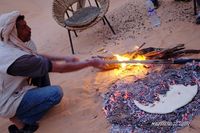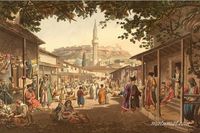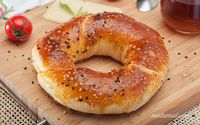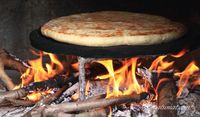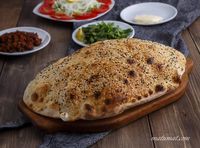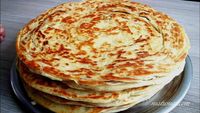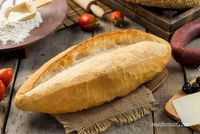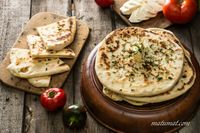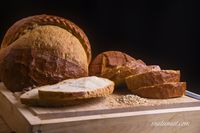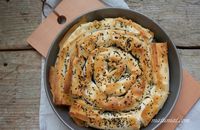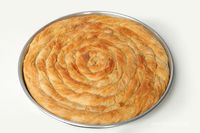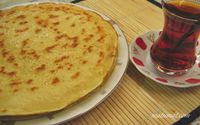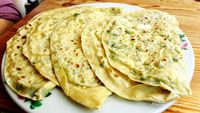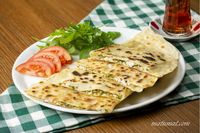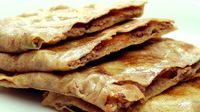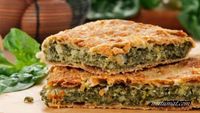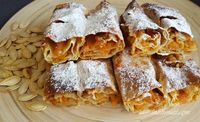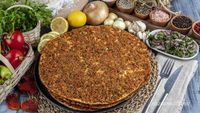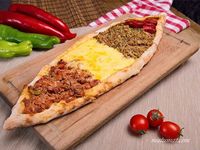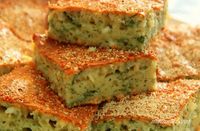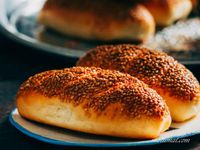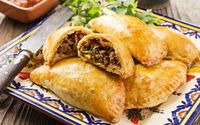Ekmek (= Bread)
Bread is a staple food in our society and the crowning glory of the table. The history of bread has been an arduous journey from the grain fields to our dining tables. According to this, people at the time observed pore formation when ground wheat grains were mixed with water. When they then baked the resulting dough, they also recognized the good taste of the bread. It is known from tradition that bread was also baked in the Stone Age. The dough was made by grinding some herbs, chestnuts and acorns and mixing them with water. It was baked on hot stones or under a layer of hot ash.
The first bread-making is based on the conversion of wheat grains into flour, which the Egyptians crushed between stones. Then they added water to make the flour dough, kneaded, shaped and baked it in oven-like cavities or on the floor. The Egyptians were also the first to use sourdough as "yeast". Fossilized samples of these loaves have been found in ancient Egyptian tombs. The Hebrews also baked their first loaves of bread flat and broke them like rusks instead of cutting them. The phrase "breaking the bread" has made it to the present day. The history of bread, one of the most widely consumed foods in Turkey, dates back to the 8th millennium BC in Anatolia. Bread has a special place in Turkey as it is an expression of respect and love in society both in the past and today. It is a symbol of tradition, work, civilization and has a cultural value. The set dining table is not perfect without bread. It's the staple on the dining table. The warm dishes made from meat and vegetables are seen as side dishes. Anatolia is known as the "grain store" and is now home to 23 wild wheat varieties and more than 400 cultivated grains. Wheat, on the other hand, was the first to be domesticated among the grains. Wheat has been described as the source of life and the right to life and was considered sacred in many ancient civilizations. Many social behaviors and beliefs reflect the centuries-old sanctity of bread. In Islam one swears not only on the Koran but also on bread just as in Christianity on the Bible. His earnings / wages are also called Ekmek Parasi (= bread money) in Turkey. In Islam one does not step on bread or food. If you see it on the floor, it will be put away so that no one will step on it. People had wondered about the behavior of Muslim football players, who picked up bread thrown on the field, kissed it and then touched it with their foreheads and then laid it aside. Exactly for this reason. Because it is food and should be treated with respect. In other countries people starve to death who don't even get a piece of bread.
In the Ottoman Empire, bread was sold at stalls, in bakeries, kiosks and alleys, as well as in markets. Fraud in the production of bread was punished. Bakers were highly respected professions that were punished for breaking rules. Even then there were very important laws for the production of bread. In 1502 Sultan Beyazıd II passed the first standardized laws. At that time it was not only the most comprehensive municipal law in the world, but also the world's first law to protect consumer rights, the first food regulation, the first standardization law and the first environmental law. The original version of this work has been in the Topkapı Museum's Reva library since 2002. The first part of the legislation is devoted to the principles of the bakery. Issues such as the inspection of the bakery, the pricing of bread, the quality and weight of the ingredients used are discussed in detail. Bread is still an indispensable food today and the bakery profession is becoming increasingly important. It is essential for a healthy diet and as a source of carbohydrates and proteins and is of great importance for nutrition.
The Turks give the products different names depending on the ingredients used, the type of baking and the hape. Traditional bread was mostly baked in Tandır ovens at home. On holidays, breads with different flavors are made by adding oil, spices and fragrant herbs. Salt, black cumin, fennel, saffron, sesame, mustard, and watermelon seeds are common ingredients. Each region has its own famous bread.
Açma
Açma can be bought fresh from the oven in every bakery in Turkey. It is made from simple yeast dough. Ordinary oil is also used. That makes the dough so soft and tender. In addition, oil is used instead of flour to knead the dough. You can also use flour, but then the dough will be less tender and less airy. In Turkey, açma are eaten with jam, also as a snack or with tea.
Bazlama
Bazlama is a Turkish flatbread that is traditionally cooked in an outdoor oven and served warm. It consists of flour, water, sugar, salt, yeast, and yogurt. During baking, bazlama is regularly flipped over in order to be evenly baked. The bread is often served with butter or olive oil, which is used as a dip.
Etli Ekmek
Etli Ekmek is a delicious Turkish pizza-like dish originating from the city of Konya. The name of the dish means bread with meat. It consists of a thin, crispy flatbread made with flour, sugar, salt, yeast, and oil, which is then topped with minced meat and finely chopped onions, tomatoes, and peppers. Etli ekmek is sometimes additionally topped with cheese before baking. Once the baked dish develops a golden-brown color, it is served cut into smaller pieces while still warm. Pair it with a glass of refreshing ayran for the best experience.
Lavaş
Lavaş is the flatbread, popular in many countries and up to one meter long in Turkey, which is served fresh from the oven with the main course in restaurants on a wooden drawer. Characteristic are the large dough bubbles that preserve the heat of the bread for a long time.
Katmer Ekmek
Katmer Ekmek is a puff pastry bread that is prepared with a lot of butter and is therefore very filling. It is more likely to be prepared in the home and is rarely available in stores.
Mısır Ekmek
Mısır Ekmek is a savory Turkish cornbread that is especially popular in the Black Sea region of the country. Its texture is usually hard and dry because it is prepared without a raising agent. Cheese, dill, sesame, poppy, and nigella seeds can all be added to the dough in order to enhance the flavors. A specialty of the region is cornbread with sardines, which are traditionally baked in the dough. If made this way, the bread is typically consumed with yogurt as a full meal. Mısır ekmek is usually sliced into small pieces or broken in chunks, preferably with some butter, cheese, fruit jams, dips, or sauces on the side.
Pide Ekmek
Pide is a Turkish bread made with a combination of flour, yeast, sugar, lukewarm water, salt, and olive oil. Before the dough is baked, it's often brushed with egg wash and sprinkled with nigella, poppy, and sesame seeds. This bread is a huge staple in Turkish cuisine and it's often served for breakfast, lunch, and dinner. Pide is also an important part of tombik, a traditional Turkish sandwich stuffed with shredded meat.
Pita Ekmek
Pita Ekmek is a round pocket bread and a staple of Eastern cuisine for more than 4,000 years. Pita is a simple flatbread that is easy to make, but the possibilities to stuff it, dip it, and wrap it are virtually infinite. The bread is baked at high temperatures so the flat dough expands quickly, developing a steam-formed pocket on the interior. Pita is the perfect choice for steaks, lamb, falafel, kebabs, or chicken. When made with whole wheat, it is highly nutritious and a great source of protein and fiber, with a very low-fat content. Today, some modern variations include pita paired with avocado and eggplants, that is perfect for dipping sauces.
Ramazan Pide Ekmek
Ramazan Pide is a traditional Turkish leavened bread shaped into round, flat forms. It is made with flour, water, milk, yeast, sugar, salt, and either butter or olive oil. Traditionally consumed during the month of Ramazan, the bread is characterized by its top which is decorated with crisscross patterns or dimples made by pressing into the dough with one’s fingers. Before baking, Ramazan pidesi is typically sprinkled with sesame and nigella seeds.
Simit
Simit is a circular bread that's commonly accompanied by either tea or ayran (= yogurt drink) and consumed for breakfast with cheese, pastırma (= cured beef) and fresh vegetables. It is believed that simit has been baked in Istanbul since the 16. century, while the name hails from the Arabic word "samīd", meaning white bread or fine flour. The dough itself is very similar to that of a bagel, except instead of boiling, the proofed dough is shaped and dipped into fruit molasses with water before being baked with a coating of toasted sesame seeds on top.
Somun Ekmek
Somun Ekmek is the everyday bread that you can buy fresh every day everywhere in Turkey. In my childhood I was often sent to buy bread. I was happy to do that too. Because on the way home I always ate a piece of bread, especially the crispy corner. After conquering the city of Bursa, the Sultan Orhan I (1281-1362) inspected the bakers on the slopes of Uludağ. In one of the bakeries, a bread with 3 slices on the surface caught his attention. He asked the baker why there were 3 cuts on the bread. The baker said: 'We are Christians. We draw three lines for the Trinity in Christianity. Thereupon he issued a decree with the words: "From now on all Muslim bakers draw a line on the bread to show that there is no god but Allah."
Tandır Ekmek
Tandır Ekmek describes the preparation method in a clay oven. The dough is skilfully thrown against the walls inside the oven pit, where it sticks during the baking process.
Vakfıkebir Ekmek
Vakfıkebir Ekmek is a large, round loaf of bread with a dough that is a little coarser than ordinary white bread. The bread is more durable and tastier than normal white bread. Nowadays available in almost all bakeries in cities.
Yufka
Yufka is a traditional Turkish flatbread consisting of flour, water, salt, and olive oil. The unleavened dough is typically rolled with a rolling pin until it develops a paper-thin consistency. It is believed that yufka is an earlier form of phyllo dough. It can be used in the preparation of numerous Turkish pastries, and it is sturdy enough to hold all of the fillings for a shawarma sandwich.
Pastry (= Hamur işi)
Börek
Börek is a family of baked filled pastries made of a thin flaky dough such as phyllo or yufka, typically filled with meat, cheese or vegetables. A börek may be prepared in a large pan and cut into portions after baking, or as individual pastries. The top of the börek is occasionally sprinkled with sesame or nigella seeds.
Kıvrım (= frizzy) Börek
Cizleme
Cizleme is a large and thick pancake, made with sourdough in a hot pan, with or without oil. The name Cizleme is mainly used in the Bolu region, which is known for the Thrace region.
Çubuk Börek
Çubuk (= rod) Börek or Kalem (= pen) Börek are also available with different fillings. The most common fillings are with minced meat, cheese or potatoes.
Gözleme
Gözleme is a Turkish flatbread consisting of flour, water, yeast, olive oil, and yogurt, which prevents the flatbread from going too brittle. The dough is filled with ingredients such as minced meat, spinach, potatoes or various cheeses, and is then baked on a sac-griddle. Originally, gözleme was served for breakfast or as a light afternoon snack, but today it has a status of popular fast food that can be found throughout the country's restaurants, food carts, and cafés.
With cheese
With minced meat
With spinach
Isırgan Börek
Immigrants prefer the word "kopriva" in the Balkan language when talking about nettle. Even today, immigrants in the Balkan villages of Kırklareli use this word when they talk about their dishes made with nettle. Kopriva soup, Kopriva mancarı, Kopriva pita, etc. Nettle prepared with onions, tomato paste and spices are mixed with cottage cheese. Sometimes the filling of the pastry can be made by mixing the nettle with other herbs and vegetables (purslane, poppy seeds, baby spinach, leeks, labada, etc.). This filling with nettle (koprivalı) can be used to prepare various shapes of pastries. If you want, you can prepare it like a sheet cake or place it on your baking sheet like a parallel arm cake.
Kabaklı Kol Börek
Lahmacun
Lahmacun is a flat bread made from yeast dough that is thinly topped with a spicy mixture of lamb or minced meat, onions and tomatoes before baking. Lahmacun is traditionally served with pieces of onion and a lemon quarter. Lemon juice is drizzled on the flatbread, spiced with Pul Biber (= crushed chili pepper) and sprinkled with smooth, chopped parsley, rolled up and eaten by hand.
Pide
Pide are filled bread cakes that are shaped like small ships. There are many variants that differ mainly in terms of the topping. You can top it with minced meat, cheese, spinach, potatoes or other vegetables. Pide with minced meat in particular is usually consumed with seasonal salads and cold drinks. The preparation of pide with minced meat is similar to the Etli Ekmek (see above) from the region of Konya in terms of the used materials and the method of preparation. The main difference between this Pide variant and the Etli Ekmek from Konya is that it has a flatter shape.
With minced meat
With little pieces of meat
Mixed
Plaska
Plaska is one of the most popular dishes of local cuisine in settlements of Albanian and Pomak origins, especially in the Balkan villages of Kırklareli. This appropriation is so deep that Albanian immigrants claim the court for themselves. Think of Plaska as a kind of cornmeal bread or salty cornmeal cake. Leek, which plays a leading role in many Albanian recipes, finds a place in the filling.
Poğaça
Poğaça is a type of bread baked in the oven. It can be leavened or unleavened, but only experienced cooks can make good-quality unleavened pogača, while the pastry with yeast is easier to make. It is generally made from wheat flour, but barley and sometimes rye may be added. It can be stuffed with potatoes, minced meat, or cheese, and have grains and herbs like sesame or nigella seed, or dried dill in the dough or sprinkled on top.
With minced meat
Su Börek
Su Börek is a Turkish noodle dish. In addition to pasta dough, it also consists of minced meat and cheese. In contrast to the Börek, the pasta dough is cooked from puff pastry and is therefore soft and not crispy in consistency. In the regeion of East-Anatolia, it is usually made from Chechil cheese. This is a brine cheese that comes from Armenia and is close to the consistency of mozzarella or sulguni. Pastries made with pure butter are popular in the province of Erzurum.

